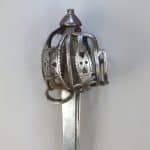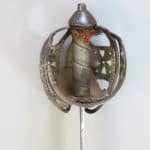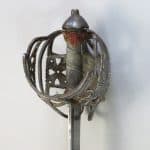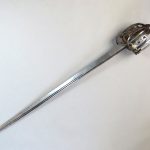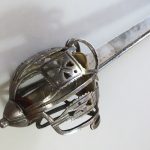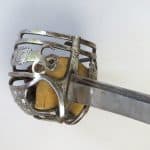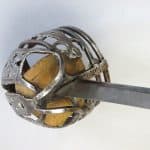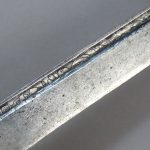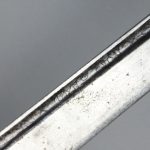
A Fine Scottish Basket Hilted Sword dating to 1720 to 1740
To enquire about this itemplease click here
Price: £8,500
Ref: 42052275
Item Description
A fine Scottish basket hilted sword from the collection of Geoffrey Jenkinson dating to the years preceding the Jacobite Rebellion of 1745. The sword was exhibited in the 1996 exhibition commemorating the 250th anniversary of the Battle of Culloden held at the Culloden Visitor Centre at the battlefield. It is also featured in the “The Swords and the Sorrows”, the publication which supported the exhibition. The sword is in fine condition and of fine quality, being well forged from sturdy iron bars and mounted with an imposing backsword blade.
The fully formed basket guard has a pleasing oval outline formed from thick rectangular section structural bars. The two primary guard plates, the knuckle bow and the secondary guard panels at the sides, are pierced with decorative designs of flanged hearts and circles and finely fretted at the edges with merlons and rectangles. The primary guard plates are further enhanced with lines along each inside edge and saltires in the middle. The knucklebow and side panels are filed with vertical wide grooves down the middles with finer lines on each side. The merlon terminal at the base of each side guard bar is pierced with a flanged heart.
The loop guard bars emanate downwards from the side guard bars and curve forwards to join the front quillon at the base of the knucklebow. The cross bar of the guard forming the front and rear quillons cants downwards from back to front in early style.
The guard arm tops are secured in a groove chiselled around the pommel just below its middle in the traditional Scottish manner. The pommel is cone shaped and mounted with a pronounced button on top of separate manufacture from which three sets of grooved lines, flanked by narrower lines, radiate to the pommel edge. This style of decoration is consistent with that applied along the middles of the side guard bars and knuckle bow as described above.
The recesses of the hilt, particularly underneath the pommel rim, show the remains of a layer of black Japanning that once covered the whole hilt (see the photos below). Japanning of sword hilts was not uncommon in the 17th and early 18th centuries. A base black layer was applied highlighted with features in gold on top. This provided both a decorative and protective layer for the exterior of the hilt. The fashion seems to have died out by the beginning of the second quarter of the 18th century when the Japanning, as in this instance, was removed.
The grip is made from a slightly baluster shaped spirally grooved wooden core of an oval cross section. It is covered with shagreen and bound with silver riband. A leather liner is mounted beneath the grip and a coloured woollen fringe at the top.
The single edged blade is of fine quality as is often found on 17th and early 18th century Scottish basket hilted swords. It has a short ricasso. A deep and well formed fuller extends from the hilt under the back edge of the blade to a distance of 7 inches (17.5 cm) from the tip. Each fuller is engraved with floral patterns on each side. These are the remnants of decoration that was once present all over the blade near the hilt, having been abraded away through cleaning over time, these remnants having been protected in the groove of the fuller. A second fuller runs underneath the first commencing 9 inches (23 cm) from the hilt and extends almost to the tip. The blade was most likely made in Solingen in Germany as were many of the high quality blades mounted onto Scottish hilts.
The sword is in fine condition overall. The hilt is noticeably robust and has maintained its pleasing oval profile. The wrist guard which is usually forged as an extension of the rear quillon has been broken off at some time in the distant past. Further evidence of use is present in an old nick in the blade near the end of the first fuller.
The sword is a fine representation of the Scottish armourer’s craft during the run up to the Jacobite Rebellion of 1745. The blade is 33.75 inches (85.5 cm) long and tapers gently to its tip. Overall the sword is 39.75 inches (100.5 cm) long.
Provenance: The Geoffrey Jenkinson Collection collection tag number 46.
Publications: “The Swords and the Sorrows”, National Trust for Scotland, 1996, page 29, plate 1:12.




